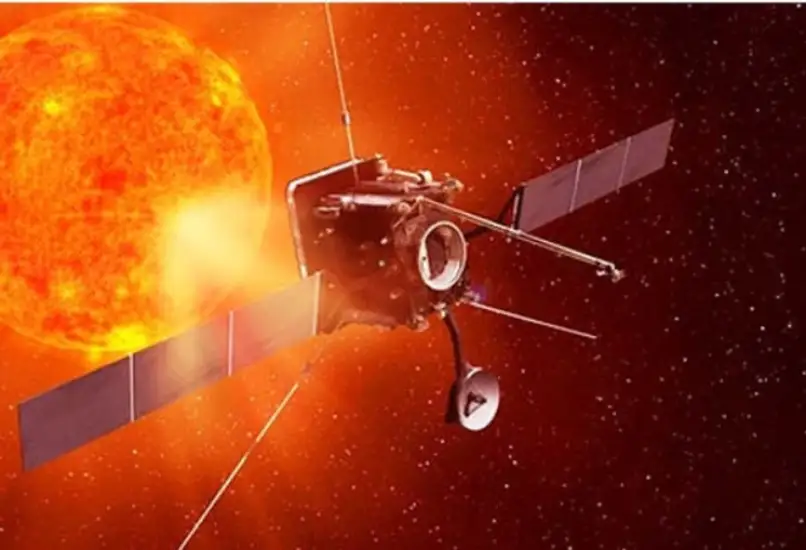Exploring the Sun’s Secrets: India’s Aditya L-1 Mission

Implementation and Objectives: The Indian Space Research Organisation (ISRO) has set its sights on launching the Aditya L-1 mission in the near future. The primary objective of the mission is to study the Sun’s corona with unprecedented precision and detail, using a suite of instruments onboard the spacecraft. These instruments will allow scientists to observe […]
Implementation and Objectives:
The Indian Space Research Organisation (ISRO) has set its sights on launching the Aditya L-1 mission in the near future. The primary objective of the mission is to study the Sun’s corona with unprecedented precision and detail, using a suite of instruments onboard the spacecraft. These instruments will allow scientists to observe the corona’s temperature, density, and magnetic fields, providing crucial insights into the processes that drive solar activity.
The mission also aims to investigate the origin of solar wind, a stream of charged particles emitted by the Sun that permeates the entire solar system. By understanding the mechanisms responsible for generating solar wind, scientists can better predict its behavior and its potential impact on Earth and other celestial bodies.
What is L1?
- L1 refers to Lagrangian/Lagrange Point 1, one of five points in the orbital plane of the Earth-Sun system.
- Lagrange Points, named after Italian-French mathematician Josephy-Louis Lagrange, are positions in space where the gravitational forces of a two-body system (like the Sun and the Earth) produce enhanced regions of attraction and repulsion.
- These can be used by spacecraft to reduce fuel consumption needed to remain in position.
- The L1 point is home to the Solar and Heliospheric Observatory Satellite (SOHO), an international collaboration project of NASA and the European Space Agency (ESA).
- The L1 point is about 1.5 million km from Earth, or about one-hundredth of the way to the Sun.
But why is studying the Sun important?
- Every planet, including Earth and the exoplanets beyond the Solar System, evolves — and this evolution is governed by its parent star.
- The solar weather and environment, which is determined by the processes taking place inside and around the sun, affects the weather of the entire system.
- Variations in this weather can change the orbits of satellites or shorten their lives, interfere with or damage onboard electronics, and cause power blackouts and other disturbances on Earth.
- Knowledge of solar events is key to understanding space weather.
- To learn about and track Earth-directed storms, and to predict their impact, continuous solar observations are needed.
- Every storm that emerges from the Sun and heads towards Earth passes through L1, and a satellite placed in the halo orbit around L1 of the Sun-Earth system has the major advantage of continuously viewing the Sun without any occultation/eclipses.
Why are solar missions challenging?
- What makes a solar mission challenging is the distance of the Sun from Earth (about 149 million km on average, compared to the only 3.84 lakh km to the Moon).
- More importantly the super hot temperatures and radiations in the solar atmosphere make it difficult to study.
- NASA’s Parker Solar Probe has already gone far closer — but it will be looking away from the Sun.
- The earlier Helios 2 solar probe, a joint venture between NASA and space agency of erstwhile West Germany, went within 43 million km of the Sun’s surface in 1976.
Problem of Heat
- The Parker Solar Probe’s January 29 flyby was the closest the spacecraft has gone to the Sun in its planned seven-year journey so far.
- Computer modelling estimates show that the temperature on the Sun-facing side of the probe’s heat shield, the Thermal Protection System, reached 612 degrees Celsius, even as the spacecraft and instruments behind the shield remained at about 30°C, NASA said.
- During the spacecraft’s three closest perihelia in 2024-25, the TPS will see temperatures around 1370°C.
Hurdles for Aditya L1
- It will stay much farther away, and the heat is not expected to be a major concern for the instruments on board. But there are other challenges.
- Many of the instruments and their components for this mission are being manufactured for the first time in the country, presenting as much of a challenge as an opportunity for India’s scientific, engineering, and space communities.
- One such component is the highly polished mirrors which would be mounted on the space-based telescope.
- Due to the risks involved, payloads in earlier ISRO missions have largely remained stationary in space; however, Aditya L1 will have some moving components, scientists said.
In conclusion, India’s Aditya L-1 mission marks a significant leap in solar research and space exploration. As the nation gears up for its implementation, the anticipation is palpable within the scientific community and beyond. The mission’s potential to unlock the Sun’s secrets and its far-reaching benefits exemplify India’s commitment to pushing the boundaries of knowledge and contributing to the betterment of humanity as a whole.





प्रातिक्रिया दे